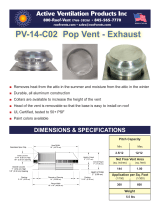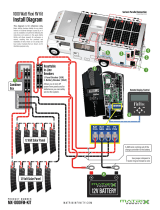Page is loading ...

Installation Guide
AB–2022
AB–3022
AB–4022
AB–6022
ATTENTION: PLEASE READ THROUGH THIS ENTIRE INSTRUCTION GUIDE
BEFORE PROCEEDING WITH YOUR INSTALLATION. MAKE SURE YOU HAVE
THE REQUIRED TOOLS AND MATERIALS TO COMPLETE THE INSTALLATION OF
YOUR SOLAR ATTIC FAN BEFORE BEGINNING.
America's Leader in Solar Powered Ventilation
GEN II SFA/SFD Model Series Fans
RE Williams Contractor Inc. www.rewci.com

Getting Started
Your Attic Breeze solar attic fan is designed for easy installation with composite shingle roofs or other low-prole roong
materials which may accommodate self-ashing roong products. For installation of our products on metal or tile roofs,
please contact Attic Breeze for information about our curb-mount fans and roof curb adapter kits designed for these
roof types.
What's Needed
Cordless Drill with Nut Driver
Self-Tapping Screws with Rubber Bonded
Washers
Reciprocating Saw
Measuring Tape
Weatherproof Roong Grade Sealant
Roong Knife
Ladder
Marker or Carpenter Pencil
Safety Information
Safety precautions should be taken when performing the roong work described in this installation guide. You can
signicantly reduce your risk of danger by following the below recommendations:
• Do not perform roong work in wet or windy conditions
• Tie-off both yourself and your equipment when working on steep pitched roofs to avoid falls
• Wear safety glasses and protective gloves when using power tools
• Always wear slip-resistant shoes when working on the roof
• Do not cut through any rafters or structural members of the roof during installation
• Leave the solar panel covered until your installation is complete
Choosing the Right Location
Choose a location to install your solar attic fan that allows for balanced air ow throughout the attic space. The solar
fan should be installed roughly centered on the roof and three feet below the ridge line. For optimum performance,
choose an area on the south side of your roof that is not shaded or blocked from the sun for extended periods
throughout the day. If a location on the southern side of your roof is not available, you may raise the solar panel
mounting bracket and face the fan unit toward the south for better sun exposure. Your solar attic fan should not be
installed any closer than within 10 feet to an existing passive vent, ridge vent, or additional fan unit.
Ventilation Requirements
In order for your Attic Breeze solar attic fan to operate at maximum performance,
your attic must have enough intake ventilation (net free area) to support the
amount of air that your fan is moving. The minimum recommended amount of
intake ventilation for your product model is shown in Table 1. Your installation
should either meet or exceed these recommendations for optimum fan
performance. If you need assistance determining the proper amount of intake
ventilation for your home, please visit our website for more information.
Your local building code may require specic fasteners or anchoring systems not discussed in this installation
guide. If installing this product in an area of either Florida or Texas that has been designated as a high velocity
wind zone area, review applicable building code requirements for additional installation instructions.
Fan Model Intake Ventilation
AB-2022 4.7 sqft
AB-3022 5.7 sqft
AB-4022 6.3 sqft
AB-6022 7.0 sqft
Table 1 - Intake Ventilation Requirements
RE Williams Contractor Inc. www.rewci.com

Installing the Fan
After choosing the location where your solar attic fan will be
installed, nd the closest rafter to that location and determine if
your roof has either 16" on center or 24" on center rafter spacing.
If your roof has 24" on center rafter spacing, nd the center point
between two rafters and mark it as the center of the vent hole. For
roofs with 16" on center spacing, mark the rafter itself as the center
of the vent hole. Partially insert a screw into the center point mark.
Using the screw as a reference point, trace out a 10" radius circle
(20" across) as shown in Figure 1. Next, use a reciprocating saw to
cut out the traced hole pattern from the roof decking. Remove the
cut out decking material from around the hole as needed.
Step 1 - Cut the Hole
Figure 1 - Cutting the Hole
10”
ATTENTION: DO NOT CUT THROUGH ANY RAFTERS OR
STRUCTURAL MEMBERS WHILE CUTTING THE VENT HOLE.
ONLY CUT OUT THE ROOF DECKING.
Insert the reciprocating saw sideways between the shingles and
roof decking. Starting at the 3 o’clock position of the vent hole,
begin cutting in a sweeping motion under the shingles, sawing
through any roong nails or staples. Continue cutting counter-
clockwise around the vent hole until reaching the 9 o’clock
position. Using a roong knife, cut a 4 inch horizontal slit in the
shingles at the 9 o’clock and 3 o’clock positions of the hole,
allowing the fan’s ashing to slide underneath the shingles.
Step 2 - Release the Shingles
Figure 2 - Releasing the Shingles
3 o’clock
9 o’clock
12 o’clock
4"cut
If your Attic Breeze fan is equipped with a unit mounted (attached)
solar panel, please proceed to the next section. For Attic Breeze
models featuring a remote mounted solar panel, the solar panel
will be mounted prior to installation of the fan unit.
Step 3 - Remote Mounted Solar Panel
Begin by locating the power cable included with your Attic Breeze
solar attic fan. Make sure the power cable is long enough to reach
the location where the remote solar panel will be installed.
Install the solar panel mounting brackets per the instructions included with your specic Attic Breeze bracket kit. Plug
in the power cord to the connector on back of the remote solar panel and securely mount the solar panel/bracket
assembly as required to your roof or structure.
If additional power cable length is needed for your
installation, Attic Breeze offers a 40 foot extended power
cable as an available option.
Route the power cable through the attic, starting from the vent
hole area to the location where your remote solar panel will be
installed and secure the power cable in place. The power cable
may be routed out of the attic by bringing the cable through an
existing passive vent, penetrating a gable wall and running the
cable along the roof eve, or simply routing the power cable directly
through the roof. When making any wall or roof penetration, caulk
around the penetration using a roof-grade weatherproof sealant.
RE Williams Contractor Inc. www.rewci.com

Figure 3 - Mounting the Fan
Adjusting the Solar Panel
The solar panel on your Attic Breeze solar attic fan may either be left down in
the horizontal mounted position as received from the factory, or the solar panel
bracket may be raised to pivot the solar panel toward the south in order to get
better sun exposure.
DO NOT OVER TIGHTEN THE SET BOLTS! You may damage your bracket
if too much torque is applied to the set bolts.
Warranty Registration
YOUR WARRANTY MUST BE REGISTERED WITHIN 90 DAYS OF
INSTALLATION.
Remove all packaging material and tape from your fan. Position the fan so that it is centered with the vent hole and
allow the control cable (and remote power cable connector if present) to hang freely from the bottom of the fan unit.
Locate the control switch envelope included with your solar fan, or if installing a Breeze Mate® control system, please
follow the instructions included with that product at this time. Plug the control switch or Breeze Mate® connector into
the fan’s control cable connector. For models featuring a remote mounted solar panel, plug the power cable from the
solar panel into the power cable connector on the fan (black cable).
Step 4 - Mount the Fan
ATTENTION: KEEP THE SOLAR PANEL COVERED DURING INSTALLATION.
After the control switch is connected, your Attic Breeze solar fan may
begin operating immediately when exposed to sunlight.
Lifting the fan unit up at an angle, apply weatherproof caulking to the bottom
side of the fan unit (see Figure 3). Align the fan unit with the vent hole so that
the sticker "solar panel pivots this way" is facing the desired direction. If the
solar panel is to remain in the at unraised position, the sticker will be on the
topside (12 o'clock position) of the fan unit.
With all fan cables connected and hanging inside the vent hole, slide the fan
unit underneath the shingles until the fan reaches the top of the hole. Secure
the fan ashing to the roof with self-tapping screws through the pre-drilled
holes in the base ashing. Apply caulk around the fan unit where the shingles
meet the ashing, across the 4" slit cuts, and over any exposed screw heads to
weatherproof your installation.
Attic Breeze offers an industry leading LIFETIME WARRANTY on your new solar
attic fan. For more information about the terms and conditions of our warranty,
please see our website for details. Thank you for choosing Attic Breeze!
ATTENTION: Do not raise the solar panel if installing this product
in an area of either Florida or Texas that has been designated as a
high velocity wind zone area. The solar panel must remain in the at
horizontal position due to building code requirements.
Figure 4 - Adjusting the Solar Panel
LOOSEN SET BOLTS
RAISE SOLAR PANEL
To raise the solar panel, rst loosen the set bolts on the solar panel mounting
brackets using a 7/16" wrench as shown in Figure 4. Raise the solar panel to the
desired tilt angle using the provided adjustment slots and tighten the set bolts.
RE Williams Contractor Inc. www.rewci.com
/





